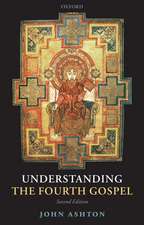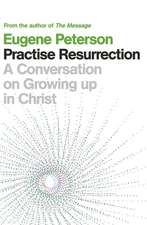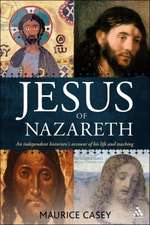'All of You are One': The Social Vision of Gal 3.28, 1 Cor 12.13 and Col 3.11: The Library of New Testament Studies
Autor Bruce Hansenen Limba Engleză Paperback – 26 iun 2019
Hansen argues against prevalent views that the unity formula employed in Gal 3.28, 1 Cor 12.13 and Col 3.11 reflects either a Hellenistic anthropology of ideal androgyny or a modern liberal conception of social equality.
Rather, Hansen contends, attention to function and context demonstrates each epistle's vision of social unity. Insights from ethnic theory elucidate how epistles characterize this unity in terms of a new social identity, and the practices warranted by that identity. Furthermore, Hansen claims that because identity construction is continual, dynamic and discursive, alternate identities (e.g. ethnic, gender, religious, economic) within the new Christian communities, may be seen as influencing one another and may be termed as the collective Christian identity.
Hansen employs theories from Ethnic study as tools for assessing how such overlapping identities persist and interact with one another. His analysis thereby demonstrates that the social unity promoted by this formula opposes cultural dominance by any particular group and, conversely reinforces the persistence of marginal social identities within new communities. The issue is then not one of gender equality, but of the equality that Paul wishes to develop between competing social groups.
| Toate formatele și edițiile | Preț | Express |
|---|---|---|
| Paperback (1) | 231.16 lei 6-8 săpt. | +85.32 lei 6-12 zile |
| Bloomsbury Publishing – 26 iun 2019 | 231.16 lei 6-8 săpt. | +85.32 lei 6-12 zile |
| Hardback (1) | 890.62 lei 6-8 săpt. | |
| Bloomsbury Publishing – 18 noi 2009 | 890.62 lei 6-8 săpt. |
Din seria The Library of New Testament Studies
- 34%
 Preț: 509.52 lei
Preț: 509.52 lei - 22%
 Preț: 832.58 lei
Preț: 832.58 lei - 22%
 Preț: 832.09 lei
Preț: 832.09 lei - 24%
 Preț: 190.33 lei
Preț: 190.33 lei - 22%
 Preț: 832.65 lei
Preț: 832.65 lei - 23%
 Preț: 191.31 lei
Preț: 191.31 lei -
 Preț: 221.70 lei
Preț: 221.70 lei -
 Preț: 98.92 lei
Preț: 98.92 lei - 31%
 Preț: 830.87 lei
Preț: 830.87 lei - 22%
 Preț: 834.60 lei
Preț: 834.60 lei - 22%
 Preț: 831.59 lei
Preț: 831.59 lei - 30%
 Preț: 717.05 lei
Preț: 717.05 lei - 22%
 Preț: 835.03 lei
Preț: 835.03 lei - 30%
 Preț: 511.40 lei
Preț: 511.40 lei - 24%
 Preț: 190.33 lei
Preț: 190.33 lei -
 Preț: 158.77 lei
Preț: 158.77 lei - 30%
 Preț: 510.04 lei
Preț: 510.04 lei - 22%
 Preț: 832.99 lei
Preț: 832.99 lei - 30%
 Preț: 509.52 lei
Preț: 509.52 lei - 22%
 Preț: 832.80 lei
Preț: 832.80 lei - 22%
 Preț: 831.76 lei
Preț: 831.76 lei - 22%
 Preț: 834.93 lei
Preț: 834.93 lei - 22%
 Preț: 831.59 lei
Preț: 831.59 lei - 22%
 Preț: 832.41 lei
Preț: 832.41 lei - 22%
 Preț: 832.99 lei
Preț: 832.99 lei -
 Preț: 414.71 lei
Preț: 414.71 lei - 30%
 Preț: 773.65 lei
Preț: 773.65 lei - 22%
 Preț: 834.93 lei
Preț: 834.93 lei - 14%
 Preț: 511.81 lei
Preț: 511.81 lei -
 Preț: 222.16 lei
Preț: 222.16 lei - 30%
 Preț: 775.67 lei
Preț: 775.67 lei - 30%
 Preț: 1012.49 lei
Preț: 1012.49 lei - 30%
 Preț: 509.02 lei
Preț: 509.02 lei - 30%
 Preț: 656.90 lei
Preț: 656.90 lei -
 Preț: 469.92 lei
Preț: 469.92 lei -
 Preț: 471.68 lei
Preț: 471.68 lei -
 Preț: 173.21 lei
Preț: 173.21 lei - 30%
 Preț: 833.64 lei
Preț: 833.64 lei - 22%
 Preț: 834.93 lei
Preț: 834.93 lei - 31%
 Preț: 772.17 lei
Preț: 772.17 lei - 30%
 Preț: 774.20 lei
Preț: 774.20 lei - 14%
 Preț: 1124.92 lei
Preț: 1124.92 lei - 22%
 Preț: 948.51 lei
Preț: 948.51 lei - 14%
 Preț: 1128.84 lei
Preț: 1128.84 lei - 31%
 Preț: 1065.91 lei
Preț: 1065.91 lei - 22%
 Preț: 777.71 lei
Preț: 777.71 lei - 31%
 Preț: 1064.84 lei
Preț: 1064.84 lei - 22%
 Preț: 1063.44 lei
Preț: 1063.44 lei - 22%
 Preț: 889.49 lei
Preț: 889.49 lei - 22%
 Preț: 1006.06 lei
Preț: 1006.06 lei
Preț: 231.16 lei
Preț vechi: 297.28 lei
-22% Nou
Puncte Express: 347
Preț estimativ în valută:
44.23€ • 46.28$ • 36.74£
44.23€ • 46.28$ • 36.74£
Carte tipărită la comandă
Livrare economică 03-17 aprilie
Livrare express 26 februarie-04 martie pentru 95.31 lei
Preluare comenzi: 021 569.72.76
Specificații
ISBN-13: 9780567689313
ISBN-10: 056768931X
Pagini: 256
Dimensiuni: 156 x 234 x 17 mm
Greutate: 0.36 kg
Editura: Bloomsbury Publishing
Colecția T&T Clark
Seria The Library of New Testament Studies
Locul publicării:London, United Kingdom
ISBN-10: 056768931X
Pagini: 256
Dimensiuni: 156 x 234 x 17 mm
Greutate: 0.36 kg
Editura: Bloomsbury Publishing
Colecția T&T Clark
Seria The Library of New Testament Studies
Locul publicării:London, United Kingdom
Caracteristici
Highlights social diversity, unity and reconciliation in Pauline ecclesiology.
Cuprins
CONTENTS Acknowledgements Abbreviations CHAPTER ONE: INTRODUCTION I. The Formula a. Formal Observations II. Previous Interpretive Approaches a. Hellenistic Philosophy b. Gnosticism c. Paul's Response to Judaism III. Ethnic Unity and Paul a. Social Unity in Paul's Churches IV. Summary CHAPTER TWO: READING PAUL ETHNICALLY I. Defining Ethnicity a. The Need for Clarity II. Genealogy and Autochthony a. Genealogy and Autochthony in Paul III. Indices of the Genealogical Criteria a. Consubstantiality: Commensality, Connubiality and Common Cult IV. Ethnic Discourse a. An Example from Hellenistic Judaism V. Acculturation, Assimilation and Ethnogenesis VI. Summary CHAPTER THREE: GALATIANS 3.28 AND THE HOUSEHOLD OF FAITH I. Introduction: Galatians 3.28 in Epistolary Context II. Disunity in Jerusalem and Antioch: Galatians 2.1-14 III. Paul's Speech: Galatians 2.14c-21 IV. Urging Unity: Galatians 5-6 V. Social Identity in Apocalyptic Perspective VI. Galatians 3-4: Identity and Unity in Christ a. Centrality of 3.28 to Galatians 3-4 b. The Singular Identity of All in Christ 1. Heirs of Faithful Abraham 2. The Cross versus the Law VII. Ethnic Identity VIII. Summary CHAPTER FOUR: 1 CORINTHIANS 12.13 AND THE BODY OF CHRIST I. Introduction a. 1 Corinthians in Socio-Historical Context b. Unity as Ethnic Identity in the Letter Opening II. Ethnicity among Images for Unity a. h9 e0kklhsi/a b. Israel c. Building d. The Body of Christ 1. The Body and Sexual Union 2. The Body and Common Cult 3. 'Body' in 1 Corinthians 12 and 15 e. Family and Household f. Summary: Ethnicity and Paul's Images for Unity III. Ethnic Identity and the Unity Formula in Paul's Parenesis: 1 Corinthians 5-14 a. 1 Corinthians 5-7 1. 1 Corinthians 5.1-13 2. 1 Corinthians 6.1-11 3. 1 Corinthians 6.12-20 4. 1 Corinthians 7 b. 1 Corinthians 8.1-11.1: Divisions over Idol Meat c. 1 Corinthians 11.2-14.40: Divisions in Worship 1. Divisions Arising from Social Status Conflicts 2. Ethnic Concord and the Body of Christ IV. Summary CHAPTER FIVE: COLOSSIANS 3.11 AND THE NEW HUMANITY I. Introduction II. Social Identity and Solidarity in Colossians 1.1-2.23 a. Colossians 1.1-23: Prayer and Thanksgiving 1. Traditional Material in 1.13-20 b. Paul's Exemplum: 1.24-2.7 c. The Polemical Core: 2.8-23 1. Apocalyptic Disruption 2. The Body of Christ III. Seeking Unity in Christ: 3.1-4.6 IV. Unity as Ethnic Solidarity a. Ethnic Criterion of Genealogy b. Confirming Indices of Ethnicity 1. Boundaries 2. Kinship Norms 3. Household V. Summary CHAPTER SIX: CONCLUSIONS I. The Aims and Methodology of this Study II. Conclusions of this Study a. Galatians 3.28 in Epistolary Context b. 1 Corinthians 12.13 in Epistolary Context c. Colossians 3.11 in Epistolary Context d. Synthesis WORKS CITED Ancient Texts Secondary Sources
Recenzii
This is a nicely put together, well-argued book... a valuable contribution to discussion of each of these three letters and of the structure of [Pau's] theology overall.
... this is an indispensable beginning point for all future studies of eschatology in 1 Thessalonians and in Paul's theology more generally.
"Perhaps the most prominent refrain the Pauline corpus, says Hansen is the affirmation that unity in Christ overcomes the social division of Jew versus Greek, slave versus free, and other dichotomies. An ordained minister in San Francisco, he explores the background of the idea, its intended purpose for original readers, and its significance to believers today. Among his topics are reading Paul ethnically, the household of faith, the body of Christ, the new humanity, and unity as ethnic solidarity." -Eithne O'Leyne, BOOK NEWS, Inc.
"Based on a doctoral dissertation presented to the University of St. Andrews in Scotland, this investigation of the Pauline formulaic affirmations that unity in Christ overcomes social divisions (Gal 3:28; 1 Cor 12:13; Col 3:11) argues that these texts support Paul's construal of the believers as a new ethnic group patterned on the identity of Israel as reenvisioned through Christ. After a 31-page introduction, it clarifies ethnic theory and rhetoric as a means of enabling readers to recognize better Paul's discursive strategy. Then it examines the three key texts: Gal 3:28 and the household of faith, 1 Cor 12:13 and the body of Christ, and Col 3:11 and the new humanity. Hansen concludes that for Paul the unity formula finds its bearings in reference to the story of God fashioning a new people on the basis of the stories of Israel and of Christ." -New Testament Abstracts, Vol. 54
'By applying the conceptual apparatus of 'ethnic theory' to the Pauline letters, he suggests that Paul attempts to supply his churches with a fictive kinship myth that renders them a new ethnos, drawn from Jews as well as Gentiles, rather than either group being subsumed to the other. In this way, Paul fashions for his churches a 'diaspora identity' (for which Hansen follows D Boyrain), but one that, rather than obliterating social differences between individuals, seeks to create a space that prevents any one pre-existing identity marker (such as circumcision) serving as a normative for all (pace Boyarin). This identity functions within a broadly bounded set of boundary-marking 'indices' that concern avoidance of idoltary and sexual immorality, and adherence to communal solidarity and Christ-like sacrificial love. There is much of value in this careful investigation.' David Lincicum, Mansfield College, Oxford
... this is an indispensable beginning point for all future studies of eschatology in 1 Thessalonians and in Paul's theology more generally.
"Perhaps the most prominent refrain the Pauline corpus, says Hansen is the affirmation that unity in Christ overcomes the social division of Jew versus Greek, slave versus free, and other dichotomies. An ordained minister in San Francisco, he explores the background of the idea, its intended purpose for original readers, and its significance to believers today. Among his topics are reading Paul ethnically, the household of faith, the body of Christ, the new humanity, and unity as ethnic solidarity." -Eithne O'Leyne, BOOK NEWS, Inc.
"Based on a doctoral dissertation presented to the University of St. Andrews in Scotland, this investigation of the Pauline formulaic affirmations that unity in Christ overcomes social divisions (Gal 3:28; 1 Cor 12:13; Col 3:11) argues that these texts support Paul's construal of the believers as a new ethnic group patterned on the identity of Israel as reenvisioned through Christ. After a 31-page introduction, it clarifies ethnic theory and rhetoric as a means of enabling readers to recognize better Paul's discursive strategy. Then it examines the three key texts: Gal 3:28 and the household of faith, 1 Cor 12:13 and the body of Christ, and Col 3:11 and the new humanity. Hansen concludes that for Paul the unity formula finds its bearings in reference to the story of God fashioning a new people on the basis of the stories of Israel and of Christ." -New Testament Abstracts, Vol. 54
'By applying the conceptual apparatus of 'ethnic theory' to the Pauline letters, he suggests that Paul attempts to supply his churches with a fictive kinship myth that renders them a new ethnos, drawn from Jews as well as Gentiles, rather than either group being subsumed to the other. In this way, Paul fashions for his churches a 'diaspora identity' (for which Hansen follows D Boyrain), but one that, rather than obliterating social differences between individuals, seeks to create a space that prevents any one pre-existing identity marker (such as circumcision) serving as a normative for all (pace Boyarin). This identity functions within a broadly bounded set of boundary-marking 'indices' that concern avoidance of idoltary and sexual immorality, and adherence to communal solidarity and Christ-like sacrificial love. There is much of value in this careful investigation.' David Lincicum, Mansfield College, Oxford












